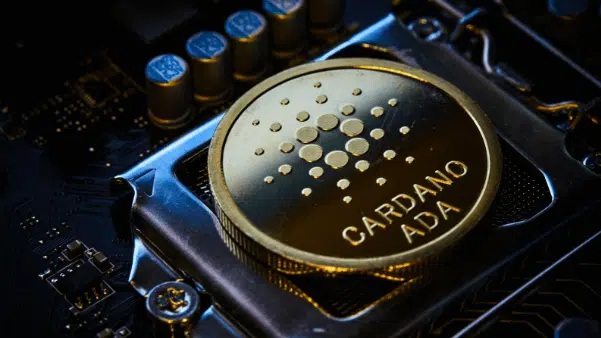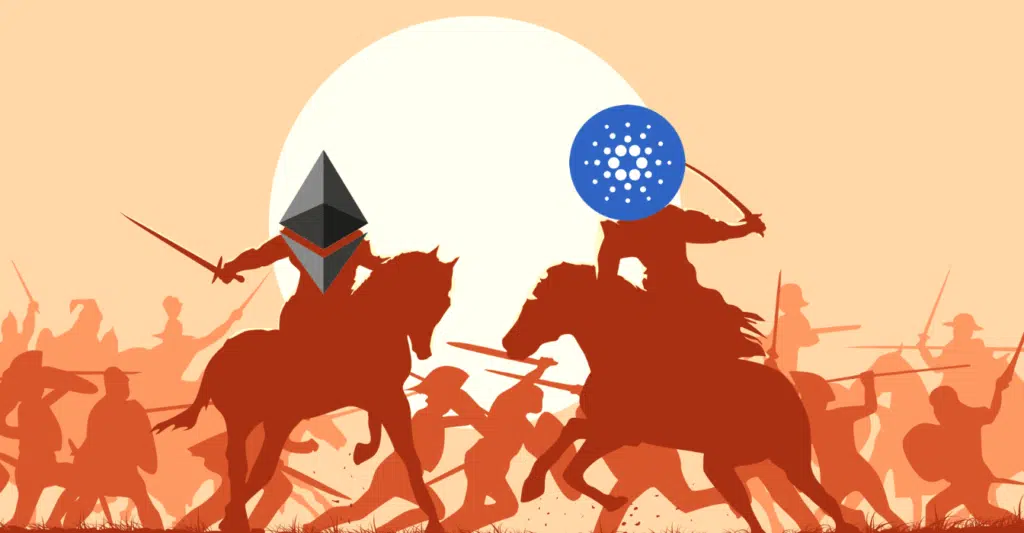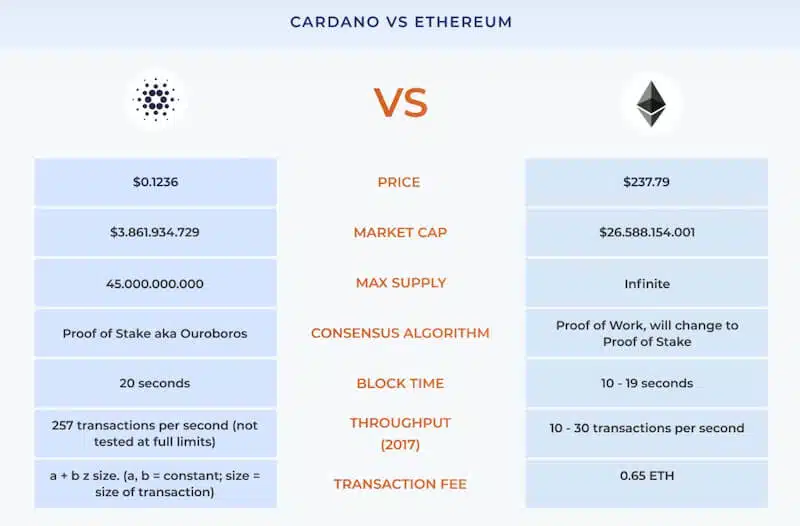TDLR
Two of the most promising blockchain projects, after Bitcoin, in the cryptocurrency sector are Cardano (ADA) and Ethereum (ETH). They offer a variety of features and capabilities, and both have emerged as critical players in the quickly developing Bitcoin and blockchain market. Which one is the champion in the Cardano vs. Ethereum battle, you ask? Read on and find out.
Cardano’s third-generation blockchain platform was created to address problems with prior blockchain generations, including scalability, interoperability, and sustainability. Cardano also uses a layer-based architecture, which enables the development of numerous levels for various functionality.
However, Ethereum, a second-generation blockchain platform, was the first to provide smart contracts and decentralized applications (dApps). Despite its speed and scalability issues, most dApp developers now use Ethereum as their preferred platform.
Ultimately, Cardano and Ethereum are powerful platforms for decentralized applications, but their underlying technology, governance models, consensus algorithms, and scalability solutions differ.

Cardano Vs. Ethereum: The Basics
In this article, we’ll compare Cardano and Ethereum to help you choose your needs. We’ll look at their features, the nuances of their underlying technology, and everything you need to know to help you make an informed decision. Let’s go.
To choose the best decentralized platform for your needs, whether for better investment opportunities or otherwise, it is crucial to understand how Cardano and Ethereum work.
Ethereum Blockchain

Created in 2013 by Vitalik Buterin, a Canadian-Russian programmer, Ethereum is a blockchain-based distributed computing platform that enables users to develop and deploy decentralized applications.
Drawing inspiration from the original Bitcoin blockchain network, the creators of Ethereum designed it as a platform for developing decentralized applications and smart contracts.
When project Ethereum began, the main goal was to advance Bitcoin’s technology so that users could conduct financial transactions with one another — peer-to-peer transactions — without needing a bank or other central authority.
Since then, Ethereum has become one of the most popular and widely used blockchain networks.
Alongside the Ethereum platform, the developers introduced their proprietary cryptocurrency token, Ether (ETH). Serving as the native token of the Ethereum network, ETH facilitates payment of transaction fees and rewards miners who contribute their computational resources to the network.
Cardano Blockchain

Cardano is an open-source project aiming to create a decentralized public blockchain network and cryptocurrency platform focusing on scalability, security, and interoperability. It is a third-generation blockchain platform that builds on the foundations of first-generation Bitcoin and second-generation Ethereum.
The IOHK team designed and developed the Cardano platform. Today, the Cardano Developers Foundation and the Input Output Hong Kong (IOHK) organization actively maintain and advance the platform.
The Cardano project was initiated in 2015 with the launch of its whitepaper. The whitepaper details Cardano’s original focuses and the project’s vision and goals, where Cardano aims to develop a secure, sustainable, and scalable platform.
Unlike Ethereum, the Cardano system provides users with a digital wallet (Daedalus) and a cryptocurrency called ADA. Users employ ADA, Cardano’s native token, to pay for transactions and procure goods and services. Additionally, ADA enables users to stake and participate actively in the Cardano network, opening opportunities for earning rewards.
Cardano’s unique features and underlying technology have made it a popular choice among investors in emerging and frontier markets.
Key features of the Ethereum platform
Smart Contracts
Ethereum operates as a decentralized platform, free from control by any single entity, and facilitates the execution of smart contracts. It runs smart contracts, which are self-executing programs stored on the blockchain and used to facilitate, verify, and enforce the performance of a contract.
Ethereum Blockchain
Ethereum leverages a proprietary blockchain technology — the Ethereum Blockchain for its binary operations. This blockchain network is a distributed ledger technology used to store and record data in a secure and immutable way. Ethereum uses its blockchain to store data related to smart contracts and transactions in the network.
Validating Transactions
Ethereum utilizes a consensus protocol to verify/validate transactions: Ethereum implements a consensus protocol called proof of work protocol (PoW) to verify transactions and ensure the network’s security. In the proof of stake protocol, miners must solve complex mathematical problems. Successfully doing so rewards them with Ether in the mining process.
However, In September 2022, Ethereum 2.0 introduced a new type of consensus algorithm called the proof-of-stake model, starting a transition away from the more energy-intensive (because it requires more computing power) Proof-of-Work (PoW) consensus.
This new algorithm allowed Ethereum users to stake their Ether tokens to secure the network and earn rewards. Ethereum 2.0 also introduced sharding, which was designed to increase the speed and scalability of the platform’s blockchain network.
Trusted Partners
Key Features of the Cardano Platform
Smart Contracts and dApps
Cardano allows for the creation of smart contracts. These computer programs can automatically execute transactions when certain conditions are met.
Cardano also provides a platform for decentralized apps (dApps) and smart contracts. The platform allows developers to create and deploy dApps, create and manage digital assets, and create self-executing smart contracts securely enforced on the Cardano blockchain.
Proof of Stake Consensus
Cardano employs consensus mechanisms called Ouroboros, created by IOHK and considered one of the most secure consensus algorithms in the industry.
Cardano’s Ouroboros rolled out leveraging the proof-of-stake model. The Ouroboros excels in providing a secure, energy-efficient, and sustainable network capable of processing transactions quickly and securely.
Multi-Layer Control
The Cardano platform leverages a multi-layer protocol consisting of the Cardano Settlement Layer (CSL) and the Cardano Computation Layer (CCL) to ensure optimal scalability and interoperability.
The multi-layer control integrates network flexibility and enhanced security, ensuring that future updates and changes can occur without disturbing the system. It also provides users safe and scalable access to distributed apps and smart contracts.
Cardano Vs. Ethereum: Key Similarities

Cardano and Ethereum are blockchain networks and platforms that enable developers to create and deploy decentralized applications. They use a proof-of-stake consensus algorithm to secure their networks and validate transactions.
Both Ethereum and Cardano offer smart contract capabilities, empowering developers to automate transactions and eliminating the need for third-party involvement. Ethereum has the advantage of being the first major blockchain to introduce smart contracts, but Cardano has made significant improvements since then, offering enhanced scaling, security, and privacy features.
Both networks can process thousands of transactions per second, with Cardano currently offering up to 25 and Ethereum capable of up to 15.
Both networks provide native cryptocurrency tokens: Cardano uses ADA, while Ethereum provides transactional money in Ether (ETH) (ADA). The two tokens are used on separate networks to pay for transactions and services.
Cardano and Ethereum offer proof-of-stake consensus, support for smart contracts, and cryptocurrency tokens. However, Cardano can have faster transaction rates and has increased scalability, security, and privacy.
Cardano Vs. Ethereum: Key Differences

Let’s explore the key differences between Ethereum and Cardano regarding their functionalities and specific use cases.
Scalability
Ethereum’s popularity often has trouble keeping up with many transactions. The network operates flawlessly under normal operating conditions. However, should transaction volumes increase exponentially, like during a bull market rally when millions of new investors are investing concurrently, Ethereum typically struggles to keep up.
On the other hand, Cardano can maintain its optimal execution speed at all times, unlike Ethereum, because its blockchain infrastructure enables scalability and can easily support large transaction volumes.
Transaction Speed
Cardano outperforms Ethereum in transaction speed, processing transactions more quickly. Unlike Ethereum, which tends to slow down under high-volume order execution, Cardano maintains efficiency, ensuring a swift transaction speed. On Cardano’s, blockchain transactions happen quickly regardless of network traffic.
Transaction volume and intrinsic value
Cardano is less popular than Ethereum. ETH processes almost 1 million transactions daily compared to Cardano’s less than 100,000.
In recent years, Ethereum has ranked second only to Bitcoin in value. ETH currently has a market cap of $992 billion, according to Coinmarketcap. Despite a significant increase in value since its inception, Cardano, with a current market cap of $12.01 billion, only accounts for less than 10% of the market capitalization of Ethereum.
The stark difference in market valuation can easily be traced back to Ethereum’s relatively broad adoption within the cryptocurrency world, as reflected in the cryptocurrency’s transaction volume.
Cost
Cardano has lower transaction fees than Ethereum. Both Cardano and Ethereum have transaction (gas) fees associated with utilizing them in transactions. But Cardano’s are considered cheap compared to ETH. On a busy day, ETH can charge up to $50 for gas fees, which are very expensive compared to Cardano’s average gas fee of $1.
Whether you intend to utilize your coin to conduct transactions and participate in blockchain initiatives should be considered if you compare Cardano with Ethereum. The distinction in transaction fees might not be significant for long-term investors hoping to HODL their assets for long-term investment. This detail, however, might be worth considering if you intend to use cryptocurrencies for Defi or other types of transactions in the cryptocurrency market.
Final Thoughts
After all, Ethereum and Cardano are powerful and innovative blockchains with different goals and approaches. They have much to offer compared to other cryptocurrencies and smart contract blockchains.
Ethereum is the world’s most popular smart contract platform and is the backbone of the booming Defi industry. Cardano is a new player but offers a more sustainable and secure platform for enterprise applications. Both projects have great potential and offer something unique to the blockchain space. Ultimately, it is up to the user to decide which blockchain is best for their needs.
Which boasts a greater market cap – Cardano or Ethereum 2.0? As of January 19, 2023, Ethereum 2.0 leads with a market cap of approximately $188 billion, overshadowing Cardano's $11.5 billion. For several years, Ethereum 2.0 has secured its position as the second-largest cryptocurrency by market cap.
In 2021, Cardano's (ADA) price surged, sparking speculation that it might surpass Ethereum (ETH). Yet, Ethereum maintains a superior market capitalization and coin price compared to Cardano.
For Cardano to hit the $100 mark, it would require a staggering 245x surge from its present price – a formidable challenge for an asset already boasting a $14.2 billion market cap. A significant supply reduction of ADA could potentially pave the way for its price to reach $100.















